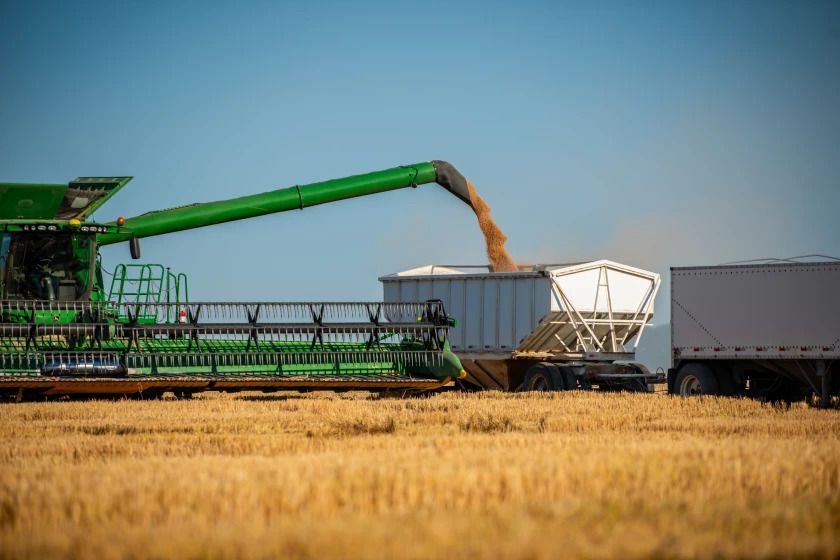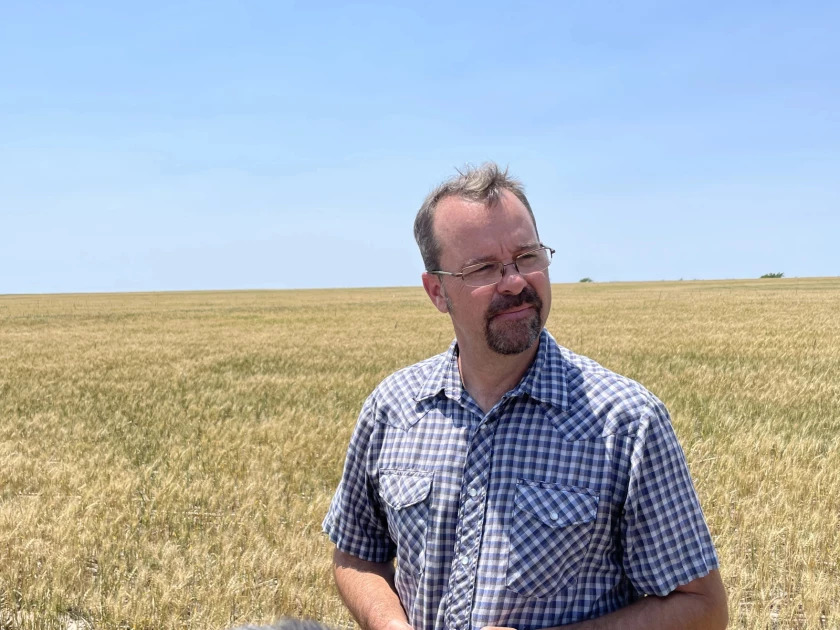
Harvest Ridge Organics harvests wheat on a field in Idaho. Farmers are hoping to get more money through commodity support programs for crops like wheat in this year's farm bill. (Kirsten Strough / U.S. Department Of The Interior, Bureau Of Reclamation)
Farmers say Title One — a farm bill program that sends money when crop prices or harvests get low enough — isn’t working as a buffer against tough years. Yet others argue the nearly 100-year-old safety net is costing billions of dollars with few strings attached.
Crop support programs are supposed to help smooth out the edges on hard farming years. The government sends payments to keep farmers out of bankruptcy and get them back in their fields for the next planting season.
But Chris Tanner, a farmer in northwest Kansas, hasn’t gotten one of those checks in several years.
Prices haven’t dipped low enough to trigger support under Title One, the farm bill program that sends crop support payments. In fact, Tanner and other farmers said they’d probably go broke before Title One kicks in.
“It’s well below the cost of production,” he said. “It wouldn’t even come close to paying half of your input costs. The prices need to be updated, because it’s a joke.”

As lawmakers hash out a new Farm Bill this year, many farmers and advocacy groups are pushing for higher reference prices in the Title One program.
“Title One does not work,” Tanner said. “The reference price is far too low. I kind of jokingly referred to it as ‘If we don't get the reference price raised, it's not a safety net, it's a safety asphalt.’”
History of Title One
A few profitable farming years set the stage for the government to establish crop support programs.
Farmers grew vast amounts of wheat during World War I, answering the call from the U.S. government to feed hungry troops and allies abroad.
High prices rewarded productive farmers. But when the war ended in 1918, demand went with it. The market collapsed, and some farmers burned their grains as fuel instead of selling it for a low price.
Many farmers went bankrupt, even before endless dust storms started stirring up soil in parts of the Great Plains.
The Dust Bowl was an environmental catastrophe on top of an economic catastrophe, says Jonathan Coppess, an agriculture policy expert at the University of Illinois Urbana-Champaign.
Franklin Roosevelt’s administration stepped in by providing short-term loans, offering support for conservation practices and establishing crop insurance programs. The government also tried to keep supply and demand in check by paying farmers to plant fewer crops – sort of the way a company might cut back supply.
“If Ford Motor Company has too many cars on the market, it’s depressing prices, what do they do?” Coppess asked. “They lay off workers and they close plants and try to bring the supply back down.”
How it works today
Nearly a century later, the government still wants to help farmers through tough years. But instead of influencing supply, the government just pays farmers when crop prices dip below a certain level or revenue goes under a set amount.
Reference prices are what trigger payments under Title One, and they’re only set during farm bill negotiations every five years.
There are two main parts to Title One, according to Pat Westhoff, who leads the University of Missouri’s Food and Agricultural Policy Research Institute. Farmers have to choose between the two options.
Under the Agriculture Risk Coverage program, the government guarantees a certain level of revenue per acre for a crop. The most popular option uses a five-year average of revenues for a certain crop, pulling from farmers across an entire county.
If the county-wide revenue per acre dips below 86% of that benchmark, the government will pay farmers a small percentage of the guaranteed revenue level.
“Complicated enough for you?” Westhoff asked.
The second part is the Price Loss Coverage program. If the price for corn or another covered crop falls below a set amount, the government will make up the difference. For corn, the current reference price is $3.70 a bushel.
“It’s very low, relative to where we've been,” Westhoff said. “Last year's crop will have sold for an average of $6.60 a bushel. So $3.70 is a long way from $6.60.”
With today’s high prices and costly farm expenses, Anastasia Meyer with the University of Nebraska-Lincoln said the program doesn’t make a huge difference.
Looking at a map with data on harvests, reference prices and benchmark revenues in southeast Nebraska, she said farmers in that area on average would have to lose half their corn harvest to get $50 an acre in one program.
That doesn’t go very far when they’re spending hundreds per acre to raise the corn.
“These are not making anybody rich by any means,” Meyer said. “And they’re not going to save any farmers if prices really go downhill fast.”
Changing Title One
Frustration with Title One is something Ryan Yates with the American Farm Bureau Federation knows well.
“The resounding message we hear from farmers is that risk management is their most important tool,” Yates, who works in public policy at the Farm Bureau, said. “As Congress looks to write a bill, we need to make sure reference prices are reasonable for a safety net to be in place.”
But raising reference prices might be a tough sell as some lawmakers stonewall government spending hikes.
“We understand the politics of the world we live in,” Yates said. “Any adjustments to those reference prices will increase the cost of the bill.”
U.S. Department of Agriculture Secretary Tom Vilsack recently told a conference that raising reference prices would cost $2 billion a year.
Higher reference prices have been a common refrain from farm groups for decades, Bruce Babcock said. He’s an economist who spent years studying ag policy at Iowa State University and now teaches at the University of California, Riverside.
He’s skeptical of any raises, especially amid high commodity prices that have boosted farm incomes.
“Look at the price of corn, look at the price of soybeans, look at the price of wheat,” he said. “And if you look throughout history, the prices for chemicals and fertilizer go up whenever the farm economy booms. So which came first, the high expenses or the high incomes?”
To Babcock, Title One money is no-strings-attached and doesn’t make a big difference in farmer’s bottom lines. He wishes it was tied to environmental practices, preventing pollution or making healthy food more affordable.
“We're not getting anything for the billions that we spend on farm programs,” Babcock said. “Why not? Why don't we get something?”
Coppess with the University of Illinois Urbana-Champaign said there’s an argument that the program protects the food supply in tough years by keeping some farms from going under.
“It's relatively cheap social insurance, kind of ensuring that at the very least we're keeping some farms in operation, and we shouldn't have a problem,” he said. “It’s a way to ensure we’re not putting the food supply at risk.”
But Coppess agrees there could be new ways to think about how the payments can have the most impact.
“When all we argue about is whether the reference price should be raised, we’re not getting into a discussion on how to make the most of the money,” he said. “We should be thinking about how to actually help farmers on the ground, rather than just delivering a win for interest groups.”
This story was produced in partnership with Harvest Public Media, a collaboration of public media newsrooms in the Midwest. It reports on food systems, agriculture and rural issues.













